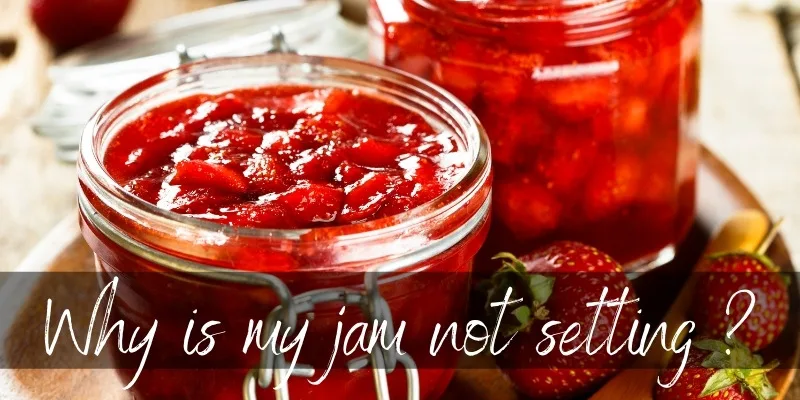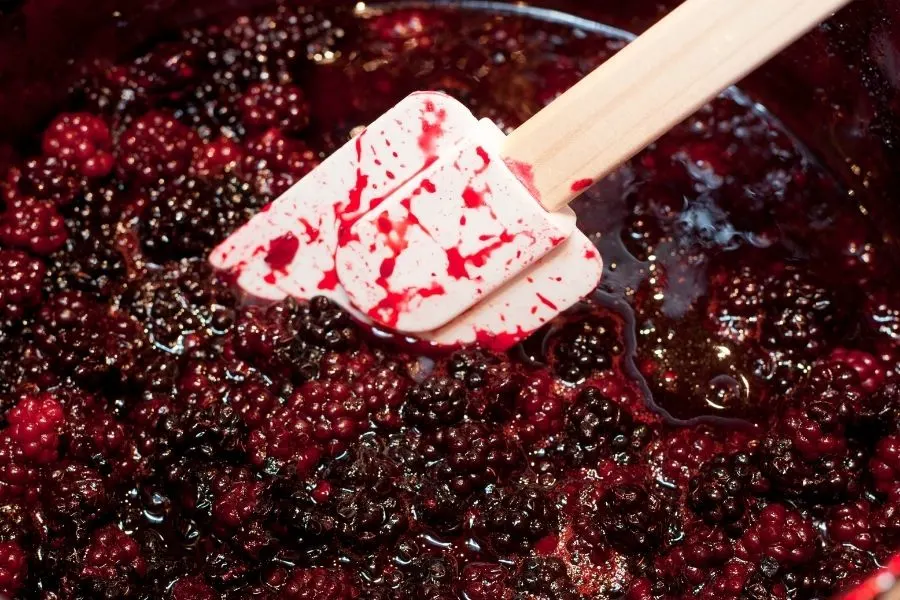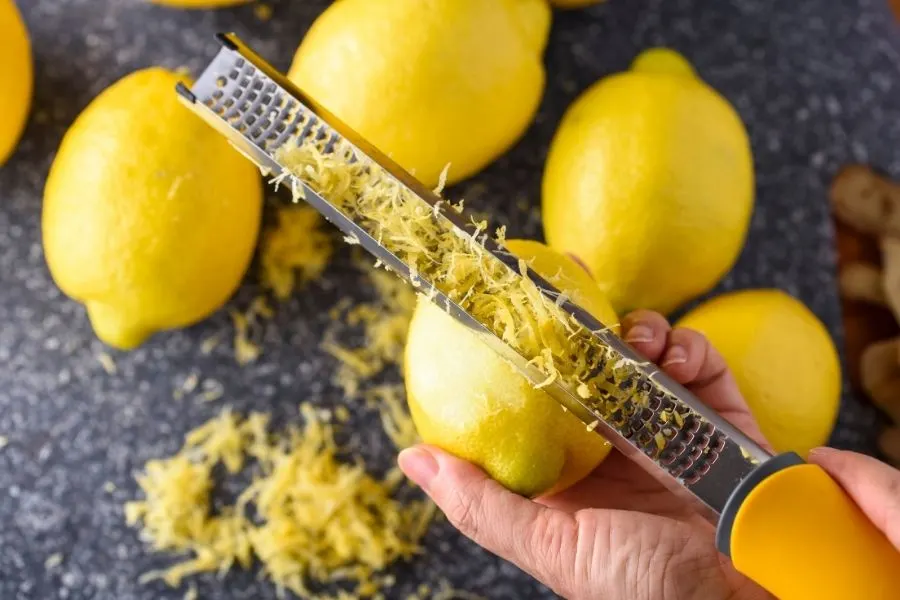Homemade jam is a beautiful thing, and a really good reason to be proud. Your family can enjoy it in any way they like, and you can make entire batches for the winter. Be careful though, once you catch the jam bug you’ll be overrun by jam jars with no place to put them (because your pantry is full anyway).
So what do you do when your jam is not setting ? Why is it not setting ? Can you fix it ? This is especially stressing and disappointing when it’s your first ever batch. Don’t worry, there are ways to fix this ! And along with how to make the jam set, we’ll tell you a few secrets about jam making so you’re always on top of your game.

Why is my jam not setting ?
Jam does not set when it does not have enough pectin, which is a gelling compound naturally found in apples, citrus fruits, cherries, apricots, and rose hips. When jam does not have pectin, the water from the fruit juice remains runny and does not bind to the sugar, so you’re left with more of a sauce than a jam.
Why doesn’t your jam have enough pectin ? You’re either using fruits low in pectin, or did not add any extra pectin. As an example, fruits low in pectin are:
- strawberries
- blueberries
- cherries
- peaches
- apricots
- pineapple
- raspberries
- plums
When making jam from any of these fruits, it’s crucial to add another fruit high in pectin, or add commercial pectin to make sure your jam does, in fact, set.
What makes jam set ?
Pectin makes jam set. Specifically it’s the bond between pectin and the sugar in jam that gels the water, leading to a thick jam, rather than a runny one. A jam made entirely of fruits low in pectin will turn out runny. You can try and ‘dry’ the jam by simmering it but you will end up overcooking the fruits, and losing their flavor.
Jams made from any of the above fruits (berries especially) are prone to this problem. You don’t want to add another fruit to not overshadow the berries, but you have to cook it much longer to get it to thicken a little, thus losing the flavor. You still need pectin.
Read also: Powdered Milk VS Evaporated Milk
Mistakes to avoid when making jam
There are a few mistakes you can make when making jam, and they’re all avoidable once you understand how jam works. The fruits provide pectin, the sugar binds to it, and part of the water is meant to evaporate, thus creating that thick, delicious jam. There are many things that can go wrong, so here’s what to look out for and how to avoid them.
Do not add any water at all
When adding your fresh fruit and sugar you may be tempted to add some water to help them get wet. Don’t ! Resist that urge. The sugar will draw out a whole lot of fruit juice from the fruits, no matter when you’re using. Sugar is amazingly good at that, just like salt.
As your mixture heats and you start to stir, you’ll notice an impressive amount of fruit juice in your pot. That’s exactly how much you need. Whatever the fruits have in them is the only amount you need, don’t add anything else.
Always stir the jam
Whatever kind of jam you’re cooking, it’s bound to start to stick at some point. The water evaporates and the mixture thickens, and you have a whole lot of sugar. That’s a perfect recipe for anything to stick to the bottom of the pan, especially on high heat.

So do your best and stir that pot, continuously. Well, in the beginning you can stir every few minutes but once it starts to reduce its contents and get thick, you need to stir continuously, otherwise you can have a nasty surprise.
You’ll work best with a pot that is either non-stick, or has a thick bottom. A wooden spoon is good, just be sure to have it very, very clean.
Use a 40/60 sugar to fruit ratio
You need the sugar for the jam to set, at least in 90% of recipes. Not enough sugar = not enough water is gelled, so you get a runny jam. If you’re looking to cut back on sugar, you have two options:
- look for a recipe that is designed for low sugar
- take a regular recipe, remove half the sugar, and add extra pectin to make it set
If you don’t supplement with extra pectin your jam won’t set as well. Of course, pectin from apples or lemons is great, but they need the sugar to work. If you’re adding extra pectin you’ll need the commercial one.
Never skip the lemon
The most common way to add pectin to a recipe is by adding lemon. it could be lemon juice, lemon rinds, or both, but it works very well. The more you add, the better the jam sets.

Keep in mind that adding lemon juice won’t make the entire batch sour, you need a lot of lemon juice for that and you have a lot of sugar in there anyway.
The lemon rind is where you should be careful. It has a lot of citrus oil, which is great, but too much can tingle your tongue and make for an unpleasant jam.
If you’re not big on lemons you can add some finely chopped apples, or better yet go for rose hips. Whatever you do, make sure the jam has some fruit that has more pectin, or at least add commercial pectin.
Always make sure the empty jars are hot
When you’re done cooking your jam, it’s ready to transfer into clean, empty jars. You’re working with hot, hot jam and you need it to still be piping hot when it gets into the jar, otherwise it won’t create that seal. But hot jam and cold jars = cracked glass and a ruined batch of jam. This is also true for pickling.
So make sure your jars are hoooot, keep them on a rack in the oven, turned on low. They should be hot enough to withstand the heat from the jam, but you should still be able to handle them. This does three things:
- sterilizes the jars, assuming they’ve already been properly cleaned
- tempers the glass so it won’t crack when you pour hot jam
- creates a seal when you close the jars.
Mash the fruit with a potato masher
If you’re considering your fruit is a bit too chunky, you can always mash it with a potato masher as it cooks. Of course, you always need to clean and cut the fruits before cooking them. Be careful when mashing the fruit, it won’t work well in the first 2-3 minutes, it works better if the fruit is already softened a little.
How to fix runny jam
If your jam is already runny, there are a few ways you can fix this. Which you use depends on what situation you’re in, and what you have on hand. Here are the most common fixes, and the ones that actually work.
Add more pectin
If you’re in the middle of cooking your jam and you just know it won’t set, break out the pectin. There are two commercial pectin versions: powder and liquid. You’d imagine in your case you’d need the powder, and you’d be wrong.
In this case, where you’ve already partly cooked the jam and the sugar has already melted, you can only use liquid pectin. Powder pectin needs to bind to the sugar crystals, which your cooked jam doesn’t have anymore. Always follow the instructions on the pectin packet and don’t skip any steps.
Add chia or flax seeds
For jams that are already cooked and cold, but not completely set, you have chia seeds and flax seeds. Both work great, but we recommend going for the chia seeds first, as they have a neutral flavor and can easily blend into your jam. In fact you can blend the seeds and jam with a blender.
The extra moisture in your jam will be absorbed by the chia seeds, and by blending them you reduce the risk of an unpleasant texture. If you’re making a strawberry jam the seeds can even blend into the jam !
You can add the chia seeds towards the end of the cooking process, or flax seeds just as well. If using flax seeds make sure to add them to fruits such as apples, pears, quince or others where a slight nutty flavor works well.
Give it time in the fridge (overnight)
You may be judging the jam too early. if you’ve just finished pouring it into containers and it still looks runny, it’s fine. It will thicken a little more as it cools. Give it time to just sit in the fridge and cool down completely. You’ll notice a big difference.
And if, for some reason, it’s not thick enough when cold, add those chia seeds and blend the jam.
In short, jam can easily be fixed, but it’s much easier to use the proper ratio and ingredients when you’re cooking. We hope these tips will help you in the future and you turn into the jam master of the neighborhood.

